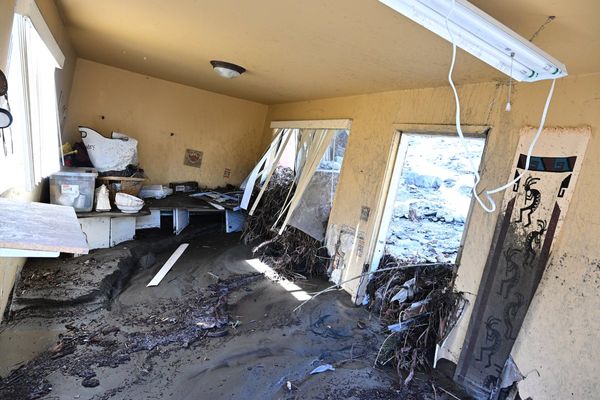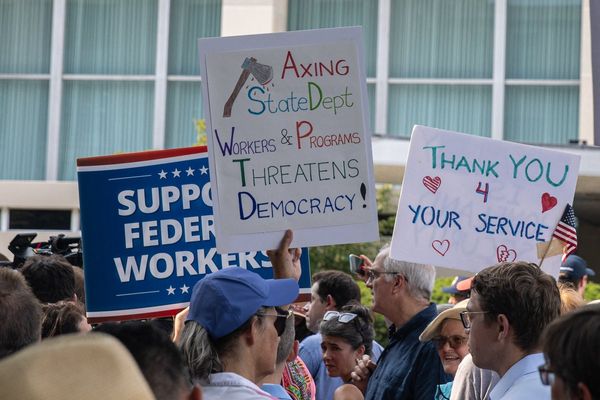
You wouldn’t have guessed he was in enemy territory. Addressing 2,500 people at New York’s Hunter College one June night in 1983, Maurice Bishop won the crowd over with ease, covering everything from the Palestinian struggle to Ronald Reagan’s Medicaid cuts. At one point, the 39-year-old prime minister of Grenada described a “secret report” from the US state department warning that the revolution he fronted was even worse for US interests than the Cuban and Nicaraguan ones.
Why? Because its leaders were young, black, socialist and, most crucially, English-speaking. The thousands of people who chanted: “Forward ever! Backward never!” with Bishop on that night showed the outsized importance that events on the tiny island of Grenada had taken on.
The scene recalled the reception Fidel Castro got on his first visits to New York. Shunned by the political establishment, he found a warm welcome from workers in Harlem and the Bronx. These new “Cubans” would be just as troublesome.
Within months, Maurice Bishop would be shot dead. Not by the forces of imperialism, but by his own comrades.
It’s too easy to see this story as just one of revolution devouring its children. Internal turmoil did break the unity of Grenada’s ruling party, leading to the murder of Bishop and a dozen others and opening the way for US invasion in 1983. But to understand why the socialist government’s time in power still resonates throughout the West Indies, we must dig deeper.
For almost a half-decade, the People’s Revolutionary Government sought creative solutions to the problems of underdevelopment, economic inequality and social oppression. Their solutions by and large worked, and that’s why we must remember them today.
The Radio Revolution
At 130 sq miles and with a population of 100,000, Grenada is the smallest country of the Windward Islands in the Caribbean Sea. The former British possession achieved full independence in 1974, amid a pitched struggle marked by mass strikes and violence. By then the prime minister, Eric Gairy, had transformed from a hero and trade union leader to a cruel and paranoid dictator.
Gairy was kleptocratic, increasingly obsessed with flying saucers and religious mysticism, and relied more and more on his “mongoose gang”, a brutal secret police force, to cling to power.
Bishop knew firsthand the dangers of opposing dictatorship. In November 1973, police broke his jaw. Two months later, his father, Rupert, was shot and killed by the regime. Bishop’s mother, fearful for her son, asked him to give up politics, but the young lawyer only threw himself deeper into the struggle.
He was already the leading member of the New Jewel Movement (NJM), a merger of opposition currents on the island. Many, like Bishop, had been ideologically shaped by the Caribbean Black Power movement, the Arusha Declaration’s African socialism and the grassroots democratic writings of the Trinidadian author CLR James.
By the time Bishop was elected to parliament in 1976 with two other NJM leaders and longtime friends, Unison Whiteman and Bernard Coard, they were all committed Marxists. With the road to state power blocked under Gairy’s increasing erratic and authoritarian rule, creating a tighter and more disciplined party along Leninist lines was seen as the key to winning power.
On 13 March 1979, while Gairy was visiting the United Nations in New York, the NJM struck. Theirs was far from a formidable fighting force. Its 46-person cadre had just 21 guns among them, mostly old carbines. According to one participant I spoke to: “Everyone else had to just make do with molotov cocktails made from old Carib bottles.” The motley force took on hundreds of government troops without a single automatic weapon.
But they had surprise on their side – and mass support. Confused soldiers at the country’s armory awoke to gunfire and quickly surrendered. The party moved next to a radio station, rallying thousands to action and announcing the formation of a new government. The bloodless takeover soon took on “the atmosphere and tempo of a festival, a carnival”, in the words of Ewart Layne, then a 20-year-old recruit.
Years of organizing and sacrifices in opposition delivered the NJM a mandate to govern. Their new People’s Revolutionary Government (PRG) soon delivered results.
The years in power
Early cables from the United States show officials scrambling to understand the new administration. After a March 1979 meeting with Bishop and Whiteman, the US ambassador, Frank V Ortiz Jr, reported to Washington that the pair were highly ideological socialists, but described them as intelligent, dedicated and hardworking young men “who by their boldness are in control of a near bankrupt, tropical slum”. He noted that “they are raising expectations and must soon produce to keep the popular support they have now”.
They did produce. For all their leaders’ zeal, the PRG oversaw economic transformation in the spirit of a visionary gradualism. They inherited, if not a “tropical slum”, the grossly mismanaged economy of a dependent country. Their new model would try to encourage and shape capitalist investment, while expanding the state sector through nationalization when necessary.
The impact was immediately felt by the public through road repairs and other infrastructure improvements. Water supply increased by 50% in the first 18 months of power, and electrification finally came to all the villages of mainland Grenada. Later, over the course of the revolution’s 1,681 days, unemployment dropped from 49% to 14%, per-capita GDP grew, home improvement grants and low-cost housing benefited thousands, universal medical and dental care was introduced, school fees were abolished and a mass campaign against illiteracy was undertaken.
Impressively, the development seemed stable. Grenada was growing despite sluggish global and regional economic conditions. In some respects, an orthodox macroeconomic approach was taken – inflation actually declined, foreign exchange controls were avoided, state-owned enterprises were made to be profitable or were allowed to fail, private investment was solicited, loans were even requested from the World Bank and the International Monetary Fund. The latter eventually commended the revolutionaries on their expansion of non-traditional exports, like agro-processed goods, while cutting a check for $7.3m.
This success came as a surprise to the US. After his first meeting, Ortiz messaged home that it was “clear Bishop needs and wants assistance badly”. His initial offer to that end was a mere $5,000, described by the PRG minister Lyden Ramdhanny as “a slap in the face”.
Ortiz cautioned restraint from his superiors, but any more US support would come with strings attached. Declaring that Grenada was “in nobody’s backyard”, Bishop found more favorable outside help from two sources: the thousands of people mobilized by the NJM, and the US’s cold war rivals.
Finding untapped human capital wasn’t hard after the events of 13 March 1979. To fix the roads, for example, the state merely had to provide heavy equipment, experts and material. They found much of their labor needs from volunteers eager to take part in what they affectionately called “the revo”. As a result, “our GDP was probably 25% larger than the official figures,” Bernard Coard, the then finance and deputy prime minister, later told me.
Citizen support was key for initiatives like the adult literacy program. A Centre for Popular Education was formed under the slogan “each one, teach one”. About 1,500 volunteer tutors taught reading, writing, mathematics, politics and science. Such mass activity manifested new bodies like the National Women’s Organisation, which activated more than a fifth of the entire adult female population to advocate for women’s equality in the workplace and at home.
Yet popular enthusiasm wasn’t enough to pull off the PRG’s most ambitious projects, like shipping port expansions and, crucially, an international airport. That’s where the Cubans came in.
Before the revolution, international lenders had agreed that an airport that allowed large passenger planes to land directly on the island would be key to increasing tourism and supporting exports. After a leftist government took power, help wasn’t forthcoming. The Cuban government provided 636 construction workers and advisers to make the Port Salines airport a reality. With large-scale projects like this, total investment increased astronomically – from $3.3m in 1979 to $37.4m in 1982.
Revolutionary suicide
By 1983, four years into the revolution, some of its luster was beginning to fade. Participation in mass organizations and popular assemblies had waned. A cash crunch threatened progress on the vital Port Salines construction. Efforts were finally under way for long-promised elections and a constitutional convention, but that would still be two years away.
International pressure was also ratcheting up on Grenada’s young leaders. Their close ties to communist countries had alarmed President Reagan. The airport project, which the World Bank called the most important “single factor in achieving the island’s growth possibilities”, became in Reagan’s account a dangerous MiG fighter base for Soviet power. Washington had earlier staged a threatening mock invasion of Grenada on the Puerto Rican island of Vieques.
There were internal threats from disaffected locals, including a bombing at Queen’s Park that aimed to decapitate the leadership and instead killed three young women and injured dozens more. The response from the government only undermined their position. Detentions grew, and the umbrella term “counters” was used to describe anyone from violent terrorists to the editors of a centrist newspaper and cannabis-growing Rastafarians.
A central committee meeting in September 1983 painted a dire picture of a party unraveling and in danger of losing power. Instead of a clear-headed look at the challenges facing the country, blame was pinned on Bishop, whose popular standing had not diminished. “The main problem,” the usually unassuming deputy minister of information, Kamau McBarnette, offered, “remains the role of comrade Bishop as the leader of the [central committee].” Others complained that their leader was “disorganized very often, avoiding responsibility for dealing with critical areas of work eg [Marxist] study class”.
The solution offered in what amounted to a political ambush was the marrying of the organizational talents of Coard, the deputy prime minister and disciplined architect of the country’s economic program, with the mass appeal and statecraft of Bishop. They would be joint leaders of the party, while Bishop remained the sole head of state.
Bishop, reeling from the stridency of the criticism but characteristically aiming for consensus, eventually submitted to the will of his central committee and party. He gave Coard a sweaty embrace at the end of a general meeting, joined in the singing of The Internationale, and invited everyone to his house for beers afterwards. Still, he questioned how the arrangement would work in practice.
Joint leadership – between Bishop and Unison Whiteman – had been the norm throughout years in opposition and he was always open to sharing responsibilities. But how could the leader of a party-state govern without control of “strategy and tactics”?
Coard described to me how he tried to reassure his childhood friend. “I told [Maurice] I was not cut out to be ‘the leader’ and he was not cut out to be ‘the maximal leader’. He was no Fidel, but I was certainly no Bishop.” By the end of the evening, Coard was confident things had been settled.
The prime minister then departed to eastern Europe on a diplomatic trip, where he talked with Grenadian delegation members about the NJM’s decision – and had a change of heart. He could not abide by an unworkable joint leadership proposal. News soon trickled back to the island about his reversal and Coard supporters made moves to prepare party and army cadres to protect their democratic processes against “one-manism”.
A power struggle ensued behind the scenes in an atmosphere of increasing paranoia. Bishop feared assassination. Coard feared Cuban intervention. A rumor spread through the island, probably conjured by Bishop in a desperate attempt to rally the masses, that Coard and his wife, Phyllis, were planning to kill the prime minister. By the middle of October, Bishop was put under house arrest.
The bizarre situation only makes sense if one understands the fatal flaw of the Grenadian revolution: its governance by a micro party. Four and a half years into the revo, full NJM members numbered in the dozens, not even the hundreds. They were expected to work in governmental positions, develop their political party and help convene mass organizations. Pushed to the limit, activists suffered from severe burnout and illness.
The 1973 New Jewel Movement manifesto asserted that “the new society must not only speak of democracy, but must practise it in all aspects”. Grassroots democracy had indeed been created in Grenada, with workers and farmers offering input on everything from development priorities to tax policy. Though its enshrinement in a new constitution was promised, for now community input at assemblies was consultatory. Big decisions were made democratically, but not through participatory or parliamentary democracy – rather through the democracy of a tiny party or its even tinier steering committees.
In what one contemporary observer described as “the airless hothouse” of marathon central committee meetings, manageable crises became existential ones. Though the revolution faced difficulties, it seemed to be on the verge of consolidation. International lending was soon to relieve Grenada’s money problems and the Port Salines airport – construction of which sucked up a fifth of annual GDP – was just months away from completion. A 1984 survey, in which 86.2% of respondents expressed favorable attitudes toward Bishop’s leadership and a majority said life got better under the PRG, suggested that free elections were likely to give the NJM a new term in office. Internal sloganeering and growing factionalism obscured the reality that they could rule transparently, as a mass party based on consent.
“Let those who labour hold the reins,” went one revolutionary slogan. Yet instead of expanding the party to include more and more Grenadians excited by the changes under way in their country, the New Jewel Movement was run by an elect already versed in the language of Marxism. The pragmatism that helped the revolutionaries win early support and run an economy successfully was seen less and less in their internal life. They demanded more revolutionary discipline of themselves and their leader and fulfilled their own alarmist prophecies of disaster in the process.
That disaster played out horrifically. Although Bishop, by the time of the October crisis, had lost the support of much of his party, he was still loved by the people. On hearing of his house arrest, workers went on strike. Tens of thousands took to the streets and marched to the prime minister’s Mount Wheldale residence. They surrounded armed guards who fired above their heads but relented without bloodletting when surrounded. “We have we leader,” the crowd chanted as a disoriented but relieved Bishop joined them and planned his next steps.
At a literal crossroads, he decided to lead his supporters to the relative security of Fort Rupert, a military installation named for his martyred father, instead of to a mass gathering at Market Square. At nearby Fort Frederick, no doubt supported by others on the central committee, an army officer – the same Ewart Layne who was so enraptured by the 1979 uprising – dispatched armored personnel carriers to retake it.
What happened next, and on whose orders, is still a controversy. After surrendering to the superior force, Bishop and other leaders loyal to him were lined up against a wall and faced a firing squad. Fitzroy Bain, a trade union organizer, pleaded with his captors. These were men he had trusted for years, and surely they knew he had done nothing to deserve death. Without getting a reply, he was shot, along with the others.
By most accounts, the eight bodies, mangled by assault rifle fire, were pieced back together in blankets and taken to be burned in an open pit. Within days, troops from the US and other Caribbean islands invaded and dispatched a regime that had lost all legitimacy.
What was left undone
Just days before Bishop’s murder, the Trinidadian labor leader George Weekes had called the house of Bernard Coard and spoken to the central committee member Selwyn Strachan. Weekes offered to help mediate the dispute and warned that “no harm must come to Maurice or anyone else”. If it did, he worried, the progressive movement in the region would be set back for more than a generation.
His worst fears came to pass. What the historian Fitzroy Ambursley called the most emancipatory moment in the English-speaking Caribbean since the slave uprisings of the 17th and 18th centuries became a cautionary tale used against all those who wanted change.
Yet amid the poverty, crime, unemployment and desperation that still plague the West Indies and the world, the New Jewel Movement’s message has not been totally erased. The Port Salines airport, completed under US occupation, was renamed Maurice Bishop international airport in 2009. Dickon Mitchell, the young center-left prime minister of Grenada, invokes the slain revolutionary’s legacy. Some might remember the revo as something more radical – proof that the oppressed of even a poor nation can stand up to the powerful and seek something better for themselves and the world.
Bhaskar Sunkara is the president of The Nation, the founding editor of Jacobin and the author of The Socialist Manifesto: The Case for Radical Politics in An Era of Extreme Inequalities







